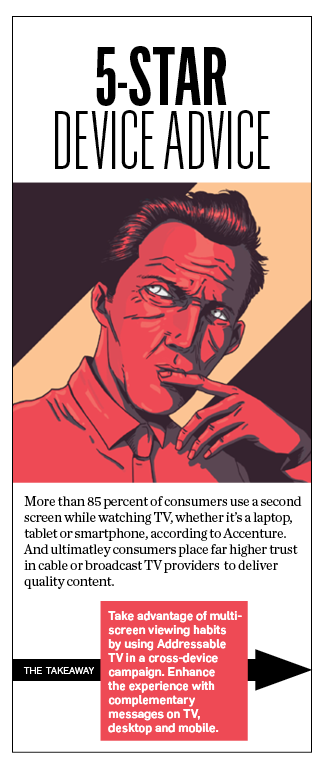For decades, TV advertisers have relied on ratings and demographic or geographic segments to buy ads. Wasted impressions and inefficient spending were just part of doing business.
Now there’s a new way to leverage data-driven targeting with addressable TV, which makes it possible to serve ads at the individual household level via set-top boxes. That means two neighbors watching the same show at the same time could see completely different ads.
Addressable TV is gaining a lot of traction in the industry because it makes it easier to show relevant content, which in turn leads to a better experience. Here’s how marketers and customers can benefit:

The user-friendly agility of addressability
With addressable TV, marketers use first- and third-party data to identify specific households most likely to respond positively to the marketers’ ads. The campaign can also be tracked in real time rather than after ratings information has trickled in. And optimization can happen much more quickly than it does for traditional ads—with the results available immediately, marketers can further tweak their messages to resonate with the customer.
For example, Honda used data-driven addressability to target 1.7 million likely luxury car buying households with ads for its Acura TLX sedan. It found those households’ rate of buying the cars was more than 60 percent higher than that of the control group not shown the ads.
Customers win in this scenario because they get to see TV spots more relevant to them. It’s about identifying the content that reaches the right type of customer for the advertiser and ensuring those ads are served to them—and them only.
How do we know it works? According to Experian, households receiving addressable advertising were 38 percent less likely to tune out ads. Clearly, relevancy affects ad engagement.
Cost efficiency and message relevancy
Addressable TV’s CPMs may seem high compared to traditional TV buys, but the additional cost is frequently offset by its improved performance. By reaching targets more effectively, addressable TV often delivers superior KPIs. In other words, targeting the right people and showing them the right ad regardless of their choice of show ensures that impressions aren’t wasted like they are in traditional TV spots.
What works with a particular audience segment can be parlayed into other channels—such as traditional TV ads, desktop and mobile—as well. Consider how addressable TV has been used during the current election cycle. “Of all the categories we work with, political probably is the most sophisticated in terms of the use of the data,” Ben Tatta, President, Cablevision Media Sales told Beet.tv in April 2016. “They will use a traditional linear schedule to get the tonnage and mass message out, and use addressable to drill home very specific, issues-based messages to very specific voting constituents.”
TV joins the cross-device mix
Whether it’s to acquire specific data on return on investment, to test creative across channels or to more effectively target customers who want to see the ads delivered to them, addressable TV is the technology that is finally changing the TV game.
Addressable TV is fast becoming an effective tactic in the world of cross-device advertising. With specific targeting, marketers can reach their customers at the household level in the living room, then follow up with digital targeting to the desktop and even mobile—ideal for when the customer is in-store and ready to buy. To the customer, it’s a seamless, relevant experience that will ultimately replace the scattershot nature of traditional TV advertising. That means no more minivan ads for the single millennial; and the new father sees ads for baby diapers, not adult ones.
The goal, of course, is to bring the pinpoint accuracy of digital targeting to TV. Consumers expect the ads they see to be relevant. Bringing a personalized experience across all devices—including TV—will be equally beneficial for marketers and consumers.









